It's amazing to me how something that seems like it should be pretty quick can become never ending. A not insignificant part of the never ending moving is that I am no longer 26. I can't haul boxes down flights of stairs as quickly, for as long, nor as efficiently as I could before. The fact that the moving isn't finished hasn't stopped me from sewing, but sewing takes much longer because I have to go upstairs for things that haven't been moved yet. It also takes longer because things are not set up efficiently yet.
Which brings me back to The Quilter's Academy. I have worked my way through the first 4 chapters, which are about setting up your space and acquiring tools. I have started getting my space and tools together, but I want to share pictures and I can't really do that yet. However, my general opinion of this section is good. As with all things, it's important to keep your own preferences in mind. What you like working with is more important than the author's suggestions. For example, I like my work areas more spread out than other people may. It forces me to move around which is important for me. My mother likes to have a pressing surface and a cutting surface she can swivel her chair (or herself) to so she doesn't have to get up. 'You do you' is REALLY important to your enjoyment of the process.
I'd like to talk about sewing machines first (not the order in the book) The book discusses types of machine and places you can acquire them on any budget. Sewing machines can be very expensive. Cheap machines are readily available, but come with some draw backs. Often the lower quality of cheap machines can become expensive, if the machine needs frequent repair work or replacement with a new machine. Some old machines, while high quality when they were new are not worth purchasing used. I had a used machine that was great when new, but the gears were made of type of plastic and after a certain time the gears deteriorated and, as they were no longer made, couldn't be replaced. We found this out after we had some regular maintenance done. The black powder that was one some things I sewed wasn't from the black velvet I had been sewing, it was the gears inside falling, literally, to dust. To make things even more fun some of these models had gears made from a different plastic, which didn't have this problem.
Some of the sewing machines recommended in the book are no longer available and there are machines currently available that weren't available when the book was written.
Finding a used machine is a good way to go, if you know a little something about them. If you are new to sewing it's hard to tell if that good deal really is a good deal AND if the problem you are having is your inexperience, or that the machine needs to be adjusted. We went on a shop hop (these are great fun - I highly recommend them) and at one of the shops a lady had brought in her machine because she was having tension issues. During a brief conversation between the quilt shop owner and the quilter I learned A LOT of things I didn't know. Were you aware that machines should always be threaded (up to the needle) with the presser foot in the up position? I always did it this way, because it's the way I was taught. Turns out that the tension on the thread doesn't set correctly on some machines if the presser foot isn't up. For a new sewer this could cause a significant amount of frustration.
Some good places to find a used machine: store that sell and service machines will sometimes take old machines in trade on new, some servicers will buy used machines and fix them up for sale.
Goodwill and Salvation Army stores have them, but not too often. You often have to take machines from Goodwill and Salvation Army on faith. They aren't tested and you often can't try before you buy. Other options include
Ebay and
Craigslist. If you get a used machine from someone other than a servicer plan to take them in for a tune-up and service after purchase. When I've had my machine tuned up it generally cost around $100. Some people recommend having your machine tuned up every year, other people recommend only having service done if your machine is having some trouble. I'm in the second camp. I don't get servicing done unless there is a problem. I am pretty dutiful about oiling my machine and replace the needles fairly often.
One machine that I recommend for consideration is
Ever Sewn. This is a newer brand (at least to me). It is on the less expensive end, but is decent quality for the price. I bought one a year or so ago. I was trying to do machine quilting and I couldn't get my, higher end, old machine to work.
My older machine is a hand-me-down from my mother. She bought it new years ago and didn't like it as much as she thought she would. It's a New Home (
Janome) Memory Craft and cost (as I recall) around $3,000 when she bought it. It is a great machine and sews well. It does embroidery (using computer program cards, which aren't available anymore). I've sewn clothes and many quilt blocks with it. I use the embroidery function to personalize things and for knitting needle cases.
The manual has a section about quilting with the machine. So I thought I'd give it a try. I was unsuccessful. The underside of the quilting was a nest of tangled threads, no matter what I did. Prior projects I'd tried quilting had also been unsuccessful and I'd read everything I could find about how to use your domestic machine for quilting. This was probably my 23rd attempt.
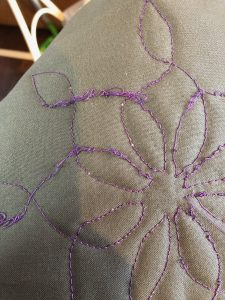
As an experienced quilter/sewing machine user, this was incredibly frustrating. In fact, I had considered giving up trying to learn to do machine quilting. (Luckily I didn't give up) I talked to the Janome dealer local to me, I hit the internet (as you do)- trying to find some help. I even watched a couple videos. I saw that
Leah Day had a blog post about Ever Sewn machines. Leah Day is a rich source of information about quilting and I am sure to post lots of links to her site, especially her information on free-motion quilting on a domestic machine. Further internet research followed and off I went to
Missouri Star Quilt Company, since not only did they have the machine, they were having a sale. It's 1.5 hours away, so not a trip for the faint of heart, but not so far it's out of the question.
Four hours (more or less) later I was home with this (the is my old sewing room set up):
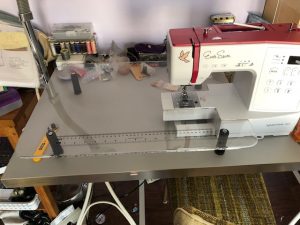
This little machine resulted in the following (and you can see a bit of Leah Day's site on my iPad in this picture).
The only change in the two samples is the machine (the lighter thread in this picture is the quilting from the old machine, I trimmed off the nests but didn't pull out all the prior stitching). And the expensive machine did NOT do a better job and the and it wasn't user error. A new quilter would be more likely to think they were doing something wrong and give up.
If you have some experience with sewing machines or have a friend or family member who can offer assistance a used machine is definitely a good option. But if you don't have experience or a helpful person to offer assistance I think it's pound foolish to take a chance on a used machine. You just never know what you're getting.
I also agree with the Quilter's Academy: spending money on a cheap new machine from a big box store is an iffy proposition. Why set yourself up for possible frustration when you're already taking up a totally new craft? As a long-time and experienced sewer I wouldn't buy a cheap machine from a big box store. Do your research, learn as much as you can about the machines you are interested in, read reviews of machines (there are a lot of them out there), most dealers will let you try out the machine before you buy (not an option at places like Walmart) and buy the best machine you can reasonably afford that is appropriate for your intended purpose.
If you have to buy a cheaper machine because you can't afford your dream machine that's okay too. I really want a new
Pfaff. I bought a new one about 20 years ago. It was a great machine, but they don't last forever, especially when you sew nearly every day. I would love to have another - some day. But right now the Ever Sewn was the best I could afford at the time and has performed very well. Do I still want a Pfaff - you bet I do. The Ever Sewn is still a great machine and I'm happy with it.
My only other commentary is to accept that not every machine works for every person. The reason I have the Janome is that my mother can NOT sew with it. For me, other than quilting, it sews like a dream. She once gave me a used Viking, she loved it. I had nothing but trouble. I couldn't sew 1 inch without it breaking the thread. New needles, a trip for servicing, different thread brands and weights - still had the same problem. Mother would come visit and use it - sewed like a dream. She'd get up and I'd sit down - nothing but trouble. I have no idea why. But if you try several machines and find you have a much better experience with a machine you can't afford, put it on your 'some day' list and save up while you build your skills.
In closing here is a picture of the most recent quilt I quilted (on the long arm). The maker was very pleased with how it came out, and that IS the main goal.
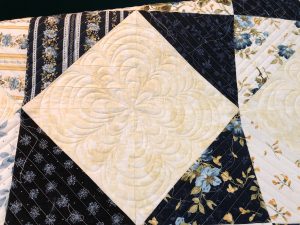
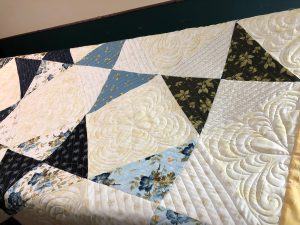
Next week - Cutting tools.
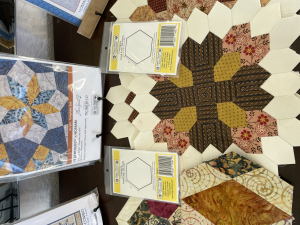 I love Katja Marek's designs. Her New Hexagon and New Hexagon 2 books are among my favorite books. Her Quilt Alongs (QALs) fill many of my BOM books. She offered QALs for free on her shop site, but you did need the patterns or books to follow along. She has since retired, I hope she is enjoying it and I also hope that she will keep designing . My Homage to Grandmother's Flower Garden is nearly complete.
I love Katja Marek's designs. Her New Hexagon and New Hexagon 2 books are among my favorite books. Her Quilt Alongs (QALs) fill many of my BOM books. She offered QALs for free on her shop site, but you did need the patterns or books to follow along. She has since retired, I hope she is enjoying it and I also hope that she will keep designing . My Homage to Grandmother's Flower Garden is nearly complete.
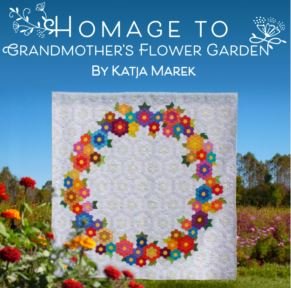 Opening the store distracted me from it, but I have pulled it back out and made a great deal of progress this month. This pattern is available from many quilt shops, including ours.
Paper Pieces has the QAL programs that Katja put together for free, but you do need the pattern or books to use the programs.
Back to my Big Project for 2025.
Along with her books she also published a perpetual calendar which has graced by desk every year since I bought it.
Opening the store distracted me from it, but I have pulled it back out and made a great deal of progress this month. This pattern is available from many quilt shops, including ours.
Paper Pieces has the QAL programs that Katja put together for free, but you do need the pattern or books to use the programs.
Back to my Big Project for 2025.
Along with her books she also published a perpetual calendar which has graced by desk every year since I bought it.
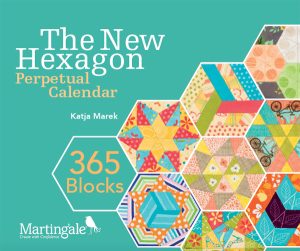 While I am going to attempt to make all the blocks from this book, I'm not crazy enough to think I could actually focus on one project long enough to make all those blocks, one a day, for a year. I know me better than that.
Instead I'm going to try to make all the blocks from her first book. There are only 52 blocks. I should be able to do that - right?
While I am going to attempt to make all the blocks from this book, I'm not crazy enough to think I could actually focus on one project long enough to make all those blocks, one a day, for a year. I know me better than that.
Instead I'm going to try to make all the blocks from her first book. There are only 52 blocks. I should be able to do that - right?
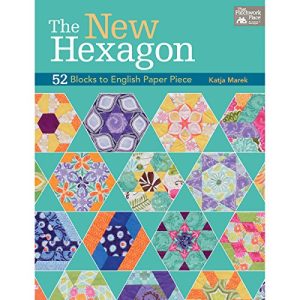 Best of all Paper Pieces has a set of all the pieces in miniature so the blocks are all done in 1" finished instead the regular size. Smaller seams should make this faster - right?
I have no idea when I purchased the pack of paper pieces for this project. I found them a few weeks ago while sorting through my scraps for some fabric to make a Mini Maker Station.
The Mini Maker Station pattern is free and well written. I highly recommend it if you are looking for a way to keep track of all your bits and tools while sitting and stitching.
She also has tutorials if you want or need some guidance. If you think you might like to make one of these but can't find the magnets and metal pieces let me know. I acquired more of them than I can use myself and I'm happy to help you out. The kits aren't offered for sale in our shop, but you can contact me through the customer service email for our online shop.
The pattern designer has offered them in her Etsy shop, but none have been available for quite some time. When I decided I wanted to make a few more of the Mini Makers (they make great gifts for your sewing family and friends) I sourced the magnets and the metal pieces, but I couldn't buy just the few I needed.
If you are interested in following along with my Big Project making tiny blocks check back next week for Block 1.
Best of all Paper Pieces has a set of all the pieces in miniature so the blocks are all done in 1" finished instead the regular size. Smaller seams should make this faster - right?
I have no idea when I purchased the pack of paper pieces for this project. I found them a few weeks ago while sorting through my scraps for some fabric to make a Mini Maker Station.
The Mini Maker Station pattern is free and well written. I highly recommend it if you are looking for a way to keep track of all your bits and tools while sitting and stitching.
She also has tutorials if you want or need some guidance. If you think you might like to make one of these but can't find the magnets and metal pieces let me know. I acquired more of them than I can use myself and I'm happy to help you out. The kits aren't offered for sale in our shop, but you can contact me through the customer service email for our online shop.
The pattern designer has offered them in her Etsy shop, but none have been available for quite some time. When I decided I wanted to make a few more of the Mini Makers (they make great gifts for your sewing family and friends) I sourced the magnets and the metal pieces, but I couldn't buy just the few I needed.
If you are interested in following along with my Big Project making tiny blocks check back next week for Block 1.
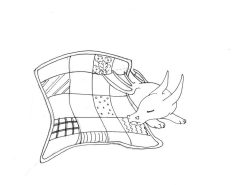
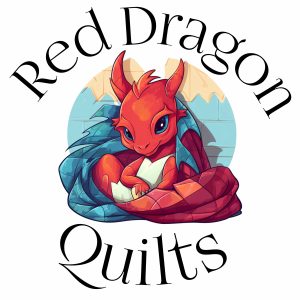
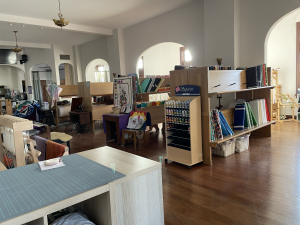
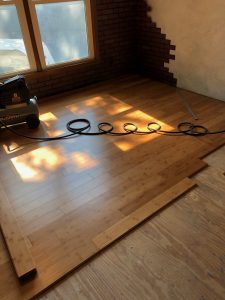 The room has some interesting decor. Faux brick and a lovely mural of NYC. (These are blocks from the Tara BOM my mother and I have been doing).
The room has some interesting decor. Faux brick and a lovely mural of NYC. (These are blocks from the Tara BOM my mother and I have been doing).
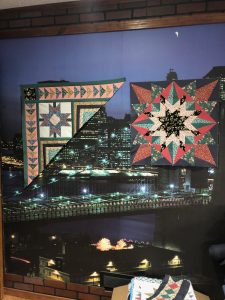 I've left the brick and the mural wall will become a great design wall. I just need to get some flannel (I think) to put up. There is a great window, lots of natural light. It faces west, though, so the sewing table can't be in the window, I'd be blinded half the day. It is a nice place for the daybed though. I need some more pillows and it will double as a nice couch for sitting and doing handwork.
I've left the brick and the mural wall will become a great design wall. I just need to get some flannel (I think) to put up. There is a great window, lots of natural light. It faces west, though, so the sewing table can't be in the window, I'd be blinded half the day. It is a nice place for the daybed though. I need some more pillows and it will double as a nice couch for sitting and doing handwork.
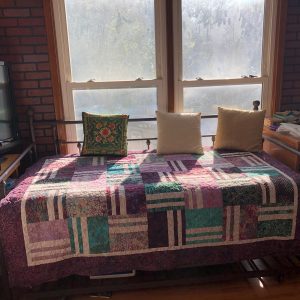 Today is the first day since we moved all the stuff that I could actually able to use the longarm. I was going to use it Sunday, but the stitch regulator wasn't working properly. I was terrified that it had gotten damaged in the move (we hired movers, because it is so heavy I didn't think we could manage it ourselves). The service line isn't open on the weekend so we just closed the door and ignored it until this morning (much harder than it sounds). Prior to calling immediately when they opened I pulled up the manual, unplugged EVERYTHING (it's the most common first step on all the FAQs) and plugged everything back in following the diagrams. VOILA - works perfectly. Thank goodness.
Today is the first day since we moved all the stuff that I could actually able to use the longarm. I was going to use it Sunday, but the stitch regulator wasn't working properly. I was terrified that it had gotten damaged in the move (we hired movers, because it is so heavy I didn't think we could manage it ourselves). The service line isn't open on the weekend so we just closed the door and ignored it until this morning (much harder than it sounds). Prior to calling immediately when they opened I pulled up the manual, unplugged EVERYTHING (it's the most common first step on all the FAQs) and plugged everything back in following the diagrams. VOILA - works perfectly. Thank goodness.
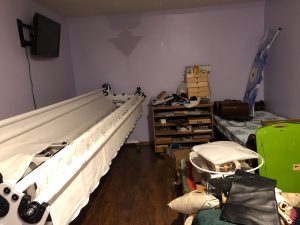 Here is a picture of the frame in place. The clutter and the cabinet have been moved out. The daybed stayed. Mother says she will sleep there when she comes to visit.
I finished up a nice charity quilt and put another on the frame. This was all done free hand and I'm pleased with how it came out. I really love edge to edge/all over quilting designs both doing them and the way they look.
≈
Here is a picture of the frame in place. The clutter and the cabinet have been moved out. The daybed stayed. Mother says she will sleep there when she comes to visit.
I finished up a nice charity quilt and put another on the frame. This was all done free hand and I'm pleased with how it came out. I really love edge to edge/all over quilting designs both doing them and the way they look.
≈ 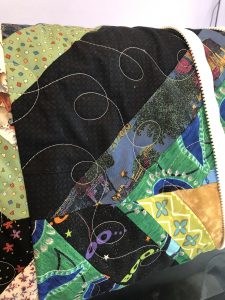
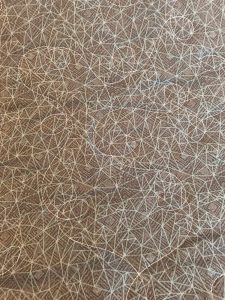 The color on the second photo is not 'true'. The backing is a great green. I'm still working on getting pictures to turn out well. Any tips? I'd love to have them.
A second is on the frame but I'm still deciding on the quilting design, and whether I'll use white thread or a lovely blue thread.
It's been a good July. I'm looking forward to more quilts (several arrived in the mail this week - look for pictures coming soon) and cooler weather.
The color on the second photo is not 'true'. The backing is a great green. I'm still working on getting pictures to turn out well. Any tips? I'd love to have them.
A second is on the frame but I'm still deciding on the quilting design, and whether I'll use white thread or a lovely blue thread.
It's been a good July. I'm looking forward to more quilts (several arrived in the mail this week - look for pictures coming soon) and cooler weather.
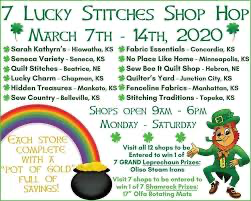 There are lots of options for participating in a
There are lots of options for participating in a 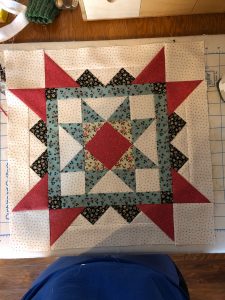
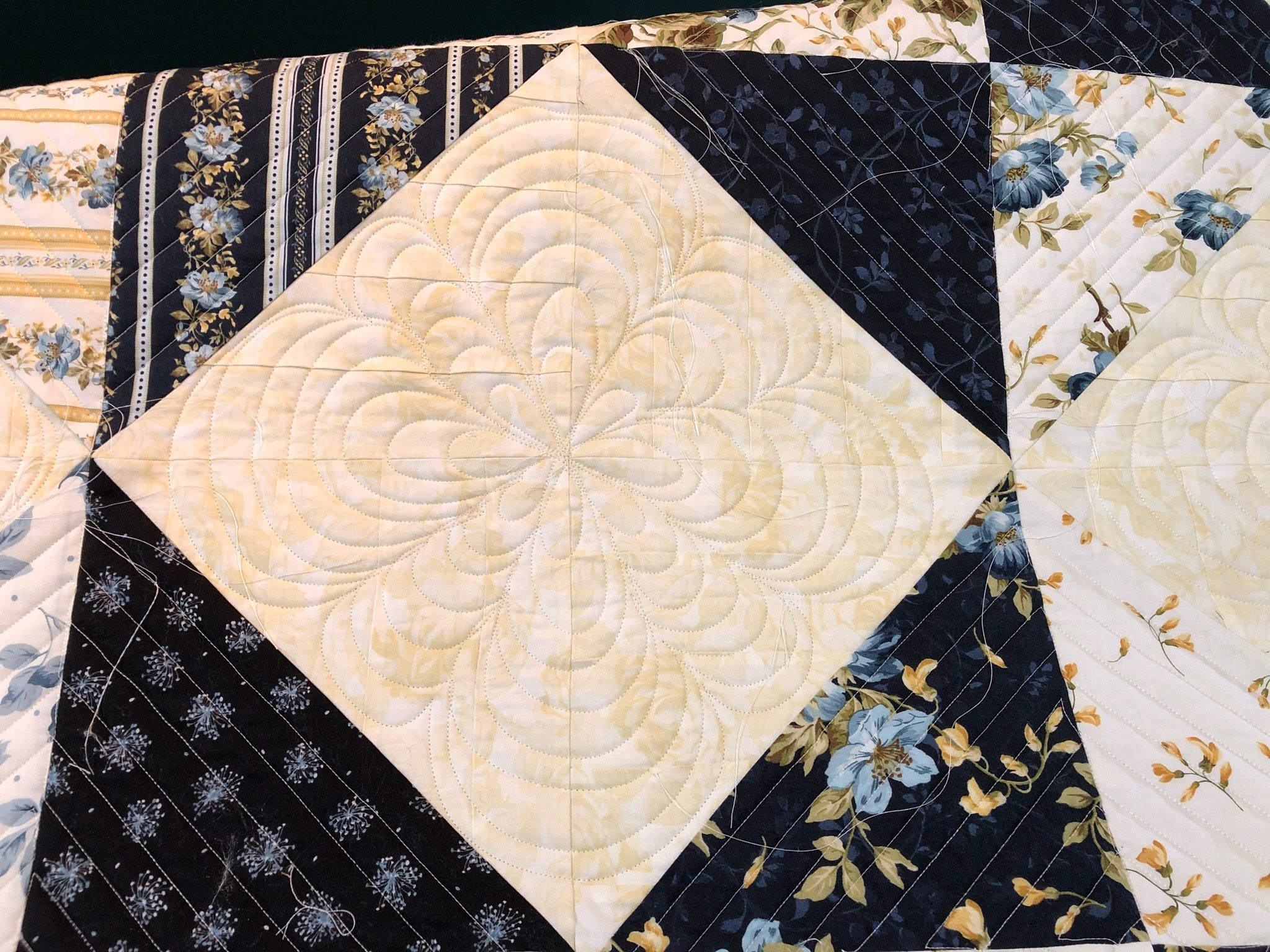


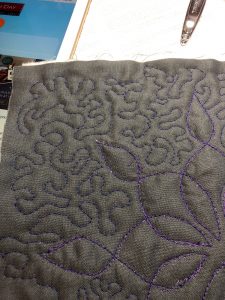


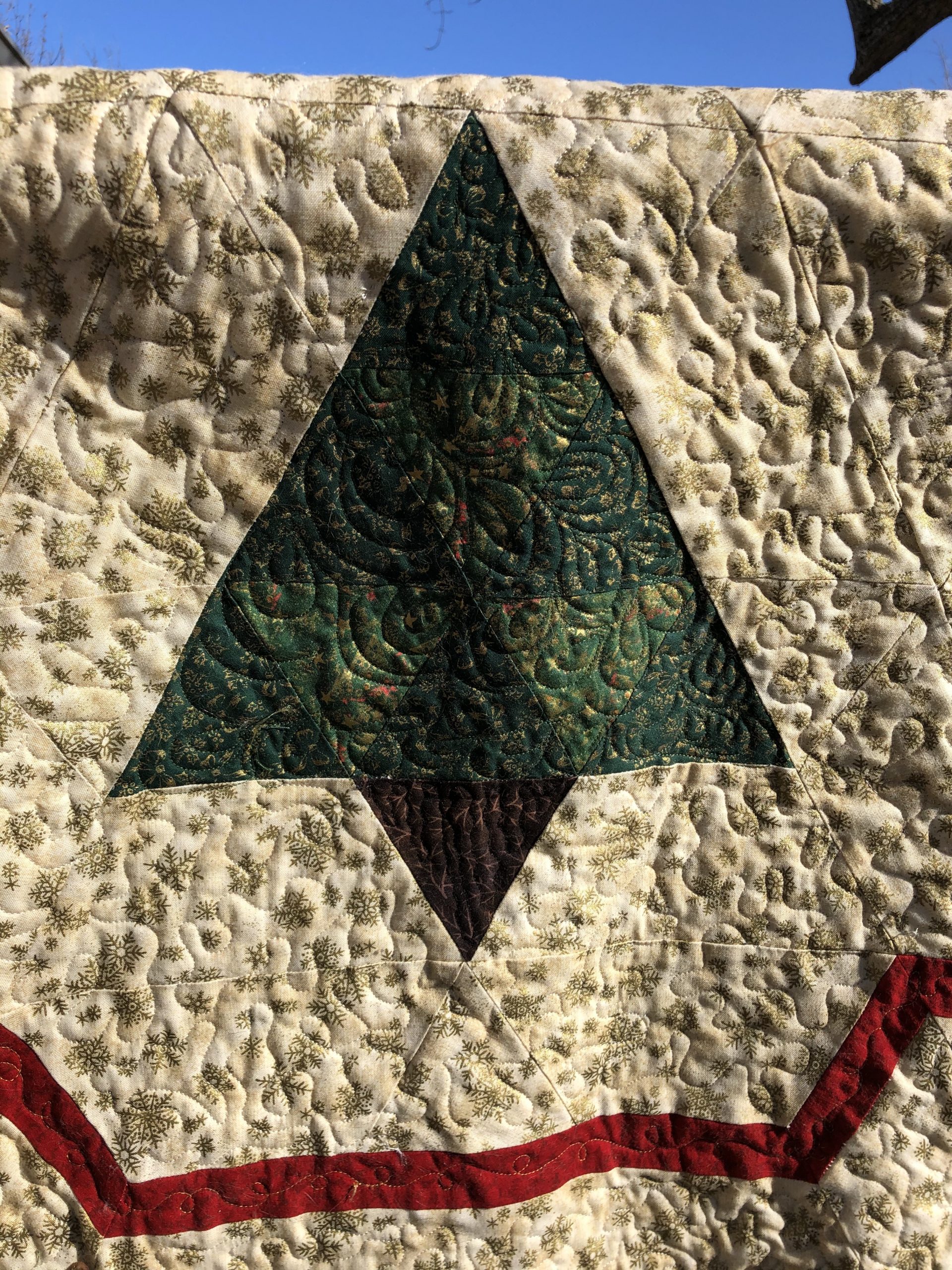
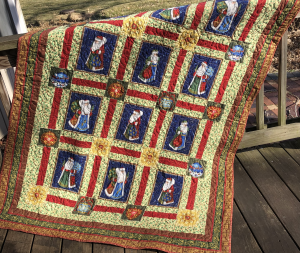 The Santa quilt was done using a holly themed pantograph.
The Santa quilt was done using a holly themed pantograph. 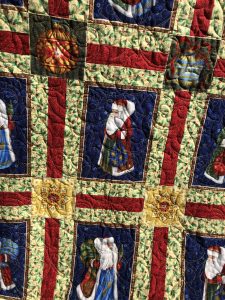 I hope this close-up helps see the quilting a little better. The quilting is done using Glide thread in gold. It has a lovely sheen. Many of the fabrics also have shiny gold designs on them so the quilting blends nicely.
I hope this close-up helps see the quilting a little better. The quilting is done using Glide thread in gold. It has a lovely sheen. Many of the fabrics also have shiny gold designs on them so the quilting blends nicely.
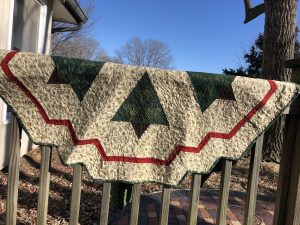 I also finished this lovely tree skirt. It was all done using free motion quilting.
I even changed the thread colors: the background is done in cream, there is a line of gold on the red trim, the trees are done in green and the tree trunks in black. It was very time consuming but I am so pleased with the results.
I also finished this lovely tree skirt. It was all done using free motion quilting.
I even changed the thread colors: the background is done in cream, there is a line of gold on the red trim, the trees are done in green and the tree trunks in black. It was very time consuming but I am so pleased with the results.
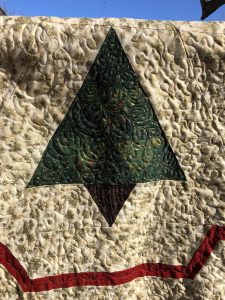 Both of these were finished just in time - hours before Rob's annual Kris Kinder party. I have been working on a free-motion whole cloth quilt - nothing to hide mistakes in the quilting except more quilting and LOTS of space to fill with interesting designs. So far all I have to show for my efforts is a tangle of thread I've pulled out. I've also ordered a couple pieces I need in order to work with rulers. It's a good thing my mother and I have a collection of tops finished and waiting for quilting.
Both of these were finished just in time - hours before Rob's annual Kris Kinder party. I have been working on a free-motion whole cloth quilt - nothing to hide mistakes in the quilting except more quilting and LOTS of space to fill with interesting designs. So far all I have to show for my efforts is a tangle of thread I've pulled out. I've also ordered a couple pieces I need in order to work with rulers. It's a good thing my mother and I have a collection of tops finished and waiting for quilting.